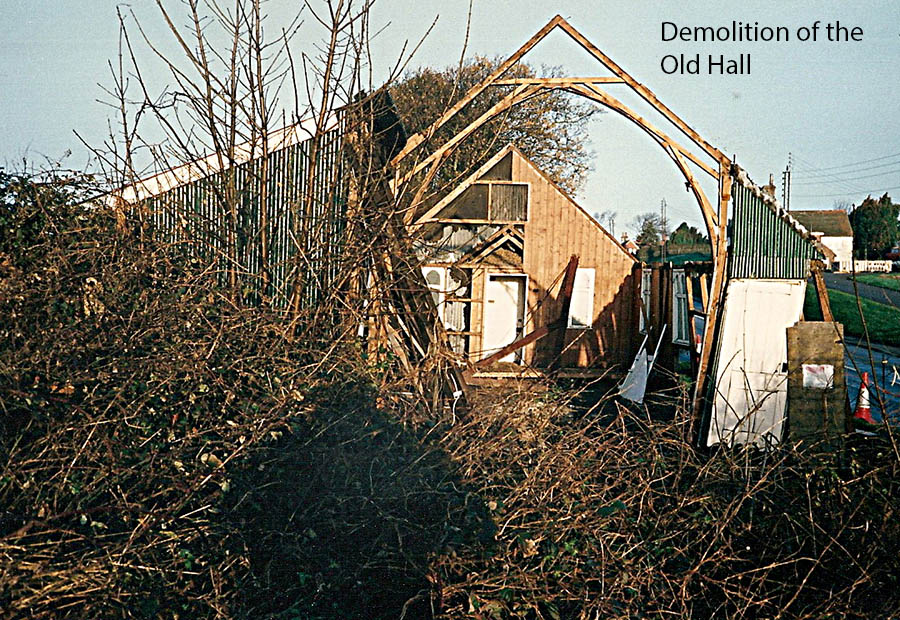Reid Hall, also known as Wartling Village Hall, was opened in 1992 on land donated by the Reid family.
The original hall was destroyed in the Great Storm of 1987.

The Bell from the old hall has been incorporated into the new building that was built with funds raised by the community and friends, as well as with a loan procured by the Parish Council.
The hall serves the local community and the wider public by providing a lovely location for all kinds of community events both private and public.

A personal perspective , by W.J.Reid
It may come as a surprise to some people to find that a parish the size of Wartling (population 446 in 2011) boasts such an impressive village hall. How did this come about?
The story of the village hall must start with the “Tin Hut”, still remembered with affection by many parishioners. In fact this building had a previous life as remembered by John Curteis in his “Notes about the Parish of Wartling between 1864 and 1938”:
“Further on is the Iron Church, built on a piece of ground given by my Father. It was opened 7-7-1889 by Archdeacon Sutton”.
In a letter to my grandparents in 1941, he corrected this:
“My nephew Herbert writes to me ‘HMC (that’s my father) did not part with the site of the Iron Church at Boreham Mill. It was leased to the Parish Council and is mine today. I receive 1/- per year rent to prove it!’ “
It is not known exactly when the Parish Council took over the Church for use as a Village Hall, but it remained in use right up until the Great Storm of 1987 damaged it beyond economical repair.
But to return to the Curteis family; John had been born in 1864 at Windmill Hill Place at the height of the Victorian era and the vogue for large country estates. The Windmill Hill Estate covered most of the parish and some of Herstmonceux Parish, including the ruins of Herstmonceux Castle and Herstmonceux Place. Most of the villagers worked on, or were connected to the estate in some way.
By 1919, circumstances had changed and when Herbert Curteis (John’s eldest brother and heir to the estate) died, his son sold almost the whole of the estate including the land at Millbarn (where the present hall stands) .There is a story that during the Second World War, the new owner of the land sought to build houses there, but was stopped by the War Agricultural Committee. The remains of an incipient sewage system can still be seen today.
My grandparents, The Venerable and Mrs. Reid, moved to Windmill Hill Place in 1938. In 1951 my father, Peter, returned to run the farm and purchased the Millbarn land from E.V. Smith and C.H. Smith. At that time Herbert Curteis still lived at Comphurst and he advised my father that he had once promised to donate land for a new village hall at such a time that it would be necessary to replace the Tin Hut. He hoped that Peter would honour this promise. There were some schemes in the 70’s and 80’s to build a new hall but none came to fruition. It was only after I took over the land in 1987 that a new hall was unavoidable, as mentioned earlier.
A committee led by Hugh Parkes of the Parish Council was formed and it was decided that a new hall should not only provide facilities for the Parish, but should be of a size that was commercially viable by making the hall attractive to as wide a range of people as possible. At this time no lottery funding was available and so a campaign of fund raising was embarked upon. The rest of the funding was from a loan and donations.
In April 1990 I, together with Hugh Parkes and Jeremy Roberts of the Parish Council, signed a Trust Deed which marked the conveyance of land to the Parish Council and also formed the governing document by which the Hall is still operated.
The initial design was a barn-like structure which could accommodate a badminton court. This design gave way to a more traditional design. It was felt better to use our limited funds on building as big a hall as possible, although this meant it was not possible to provide some features such as a permanent stage and secondary meeting room.
Nearly, two years later the Hall was opened by my father. Thus began a new era with Hugh Parkes as Chairman and Pam Gainer as Secretary/Treasurer. It was only in 2015 that they retired from the committee.
